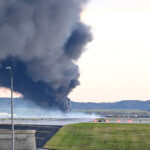Americans in the hurricane danger zone may soon be able to use Google to find out if their own home is threatened by a dangerous storm surge, the director of the National Hurricane Center said Wednesday.
Storm surge, the massive wall of water carried onto land by a hurricane, is considered perhaps its most destructive element and greatest threat to the lives of people who ignore evacuation orders in vulnerable coastal areas.
Bill Read, who was appointed head of the Miami-based U.S. forecasting center in January, said a planned program will couple a Google application with storm surge data that meteorologists have used for years to determine the flooding threat from any category of storm.
“People can plug in their address and see at what level they are at risk,” Read told Reuters in an interview.
He said he hoped the program would be available during the coming Atlantic hurricane season, which runs from June 1 to Nov. 30.
Data gathered during Hurricane Katrina, which killed 1,500 people and caused $80 billion damage on the U.S. Gulf Coast in 2005, found the storm surge reached up to 22 feet above normal sea level in eastern Mississippi.
Hurricane Andrew, the destructive Category 5 storm that hit the Miami area in 1992, pushed at least 16 feet of water ashore south of the city.
The damage a storm can cause is largely dependent on its storm surge, and whether it hits a city or a sparsely populated area. Despite the catastrophic damage of Katrina, New Orleans was spared the worst of the surge.
“With Katrina, 30 miles to the west and everything that happened in New Orleans in two days would have happened in a matter of hours because the surge would have been much worse and it would have overtopped the levees,” Read said.
Hurricane forecasters use a computerized model called SLOSH (Sea, Lake and Overland Surges from Hurricanes) that estimates storm surge heights by taking into account the size, internal pressure, forward speed, track and wind strength of a hurricane.
The idea to make it available to the public evolved from calls that inundate local emergency managers and weather forecast offices every time a hurricane threatens. Read said people ask what flooding will be like at their house.
“We’re not going to know that off the top of our heads,” he said. “So we can say ‘go to our Web site, go to such and such, and it’s there.”
Hurricane forecasters will also offer a new color-coded graphic on the NHC Web site this year that will indicate storm surge probabilities for threatened areas, similar to forecasts they now offer on wind-speed probabilities.
The graphic will indicate the probability of the surge reaching or exceeding five feet within a given number of hours, Read said.
The graphic promises to help local emergency managers with key decisions such as when to lock down bridges and which roads could be washed out or need to be cleared.
Was this article valuable?
Here are more articles you may enjoy.

 NYC Sues Delivery App Over Lost Pay in New Mamdani Crackdown
NYC Sues Delivery App Over Lost Pay in New Mamdani Crackdown  Boeing 2011 Warning May Offer Clues into 2025 UPS Jet Crash
Boeing 2011 Warning May Offer Clues into 2025 UPS Jet Crash  California Governor Seeks $200M to Replace EV Tax Credits Cut by Trump
California Governor Seeks $200M to Replace EV Tax Credits Cut by Trump  Munich Re: Insured Losses From Wildfires, Storms and Floods Hit Record High
Munich Re: Insured Losses From Wildfires, Storms and Floods Hit Record High 